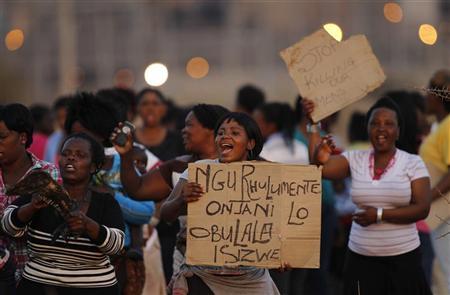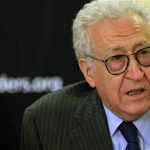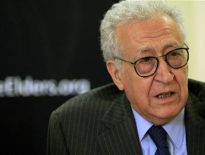By Jon Herskovitz
MARIKANA, South Africa (Reuters) – The bloody protest by South African miners that ended in a hail of police gunfire and 34 deaths this week could also wound the ruling ANC and its main labour ally, laying bare workers’ anger over enduring inequalities in Africa’s biggest economy.

Thursday’s shooting, bringing back memories of apartheid-era violence, underlined that after 18 years in power the African National Congress and its union partner have not been able to heal the fissures of income disparity, poverty and joblessness scarring the country.
The deadliest security incident since the end of apartheid has exposed grass roots discontent among the rank and file of the National Union of Mineworkers (NUM), the country’s biggest union that has been a training ground for ANC leadership and a staunch supporter of President Jacob Zuma.
“The NUM is all about politics. They have forgotten about the man in the mine shaft,” said Lazarus Letsoele, one of the striking miners at the Lonmin Marikana mine, about 100 km (60 miles) northwest of Johannesburg.
He escaped on Thursday when police opened fire on the strikers in what has been dubbed “the Marikana Massacre”, prompting a government inquiry and a wave of soul-searching in post-apartheid South Africa.
Despite billions of dollars of spending by the ANC on poverty reduction and union friendly laws to protect workers exploited by the past white-minority regime, the gap between haves and have-nots is still one of the highest in the world.
Per capita GDP is over $8,000 a year but nearly 40 percent of the population lives on less than $3 a day.
At the Lonmin mine producing the precious metal platinum used in vehicle catalytic converters and jewellery, stray dogs pick over litter-strewn, wind-swept fields of dust near the clustered corrugated tin homes that are mining settlements.
“We want more money and we want someone who can get it for us,” said a mineworker who asked to be called by his first name Paulo and lives in a shanty facing the field where the miners were gunned down.
Platinum sells for about $1,440 an ounce but a worker drilling underground at tonnes of rock face to extract it makes less than $500 a month.
“This is a strike against the state and the haves, not just a union matter,” political analyst Justice Malala wrote in the British daily Guardian in reference to people like Letsoele, who live in the mine’s shantytowns.
POWER PLAYS
Thursday’s shooting, in which a rank of police fired automatic weapons against advancing strikers, has been likened to the 1960 Sharpeville township massacre near Johannesburg under apartheid, when white-led police fired on a crowd of black protesters, killing more than 50.
South Africa’s police, now predominantly black, said they fired in self-defence at Marikana to protect themselves against men armed with spears, machetes and pistols.
Peter Major, mining consultant at Cadiz Corporate Solutions in Cape Town, said the Lonmin unrest was an ugly reminder of the social instabilities that still persist, but are often hidden by the ANC’s electoral dominance.
“These people aren’t just going on strike for better wages. There are power plays and rogue elements involved as well. And remember: these mines are surrounded by townships of thousands of unemployed people, tens of thousands often, of volatile, unemployed, uneducated people,” he said.
The ANC has enjoyed virtual one-party rule since taking over in 1994, with its nearest opponent more than 40 percent behind in the last 2011 elections. Its base of support is among poor blacks, who are loath to vote for the main opposition Democratic Alliance, seen as the party of white privilege.
Labour federation COSATU, with more than 2 million members has been a vote-gathering machine powering the ANC to victories.
Critics see what they call an “iron triangle” of power among the ANC, traditional unions and industry that enriches the politically connected and protects COSATU’s dominance, but shuts out masses of poor looking for jobs.
At Lonmin, many striking workers said they saw NUM as out of touch and too cosy with tight-fisted management.
“Workers have become increasingly disaffected by the traditional entrenched unions affiliated to COSATU – seeing cadre deployment of union management, increasingly remote and politically involved management not close to the concerns of workers on the ground,” said Peter Attard Montalto, an emerging market economist at Nomura International.
ENTWINED INTERESTS
ANC heavyweight Cyril Ramaphosa is an example of how the interests of the former liberation movement are entwined with unionism, but also with the fortunes of industry.
Anti-apartheid activist Ramaphosa helped forge the NUM in the 1980s to fight mine owners, staging several deadly strikes. He moved into the ANC’s senior leadership, using his political connections to become one of the wealthiest businessmen in South Africa. He sits on the Lonmin board as a non-executive director.
NUM has said its feud with the militant and upstart AMCU union, seen as behind the Lonmin strike, could spread, threatening a setback for labour relations in South Africa.
This could in turn feed into lower levels of investment, possibly lower growth, and a deteriorating fiscal balance.
Zuma tried to reassure investors their money would be safe, saying at a tour of the bloodied Marikana mine on Friday: “We remain committed to ensuring that this country remains a peaceful, stable, productive and thriving nation.”
But the knives are out for Zuma, who is seeking re-election as the ANC’s leader at a major conference in December. If he wins the party vote, he is almost assured of an another term as the country’s president, which would last until 2019.
Zuma is close to the NUM: his right hand man ANC Secretary General Gwede Mantashe is a former NUM leader. Any damage NUM suffers could hurt Zuma, especially with some other unions in the COSATU group indicating they want him gone.





